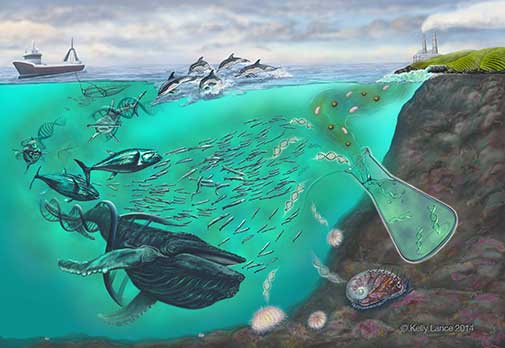To be honest, I lost most of my interest in molecular biology and genetics couple years ago (in the middle of my undergrad), mainly because I did not like the way they were taught: it involved lots of memorisation of details I could not retain for more than couple days after the final exam, as well as it seemed too abstract to me sometimes!. So I decided to focus my heart and brain solely on ecology, evolutionary and behavioural biology and avoid the molecular component as much as I could. I recognise that this is not a logical, smart or useful behaviour at all, and that it has been one of the criticisms towards ecologists and behavioural biologists who decide to completely forget about the molecular basis (however the opposite is also true when scientists merely focus on the molecular and genetic level and lose perspective of how this matters to the organism and its environment). One of the main goals of this course is to (as Owen puts it) “keep making connections” between the different topics and fields, and this can ve very valuable as you can approach the same issue from a different perspective to gain new insights.
During our field trip to Fortuna I was surprised (due to my molecular-genetic resignation) of how much I enjoyed Greg Wray’s talk “Genomic approaches to ecological and evolutionary questions” because it made me re-think of genomics as a powerful tool to try answer the questions in the areas that interested me the most. For example, genomics can be used at the different levels of biological organisation, from the individual (to study movement, hybridisation, trait-inference) to the population level (to study population size and sub-structure, amount of genetic variation), as well as at the level of communities (to investigate species interactions such as parasitism and prey-predator relationships). This made me wonder how genomics could be applied to my masters research: biological invasions.
The invasion process by an exotic species can be broken down into five different stages: transport, introduction, establishment, spread and impact. One of the current challenges of invasion ecology is to understand how the transitions between the different stages actually take place, as well as the quantification and prediction of invasive species’ impacts. Without this knowledge, it will be difficult for management practices and interventions to succeed. Fortunately, genomic approaches (to the rescue!) are being recognized as very useful tools to understand the invasion stages and to design the according management practices.

Taken from aquaticfieldcourse2013.wordpress.com
For example, genomics can be used during the initial stages of an invasion (transport and introduction) to detect the presence of invasive species throughout DNA barcoding, DNA metabarcoding (multiple species) and environmental metabarcoding (eDNA, where DNA is extracted from a sample of water or soil). The later one can be particularly useful when applied to the ballast water of ships (ballast water is responsible for a great deal of worldwide introductions), but also to have a better understanding of the ecology of microbial invasions, which can be extremely hard to detect using traditional survey methods. Additionally, genetic markers can be used to identify the source populations of introduced species, which can accelerate the management process. On the other hand, genomics can be used to study the levels of genetic variation present in introduced populations, which can help in predicting the probability that such populations become established and/or spread. This is important because it has been suggested that greater genetic and phenotypic variation increase the probabilities of a successful colonisation. Genomic tools can also be used to detect hybridisation (either among invasive species or among introduced and native species). Hybridisation has been shown to facilitate the invasion process (as it increases genetic and phenotypic variation) but also can have a direct impact on native species through “genetic pollution”. Finally, using genomic approaches one can identify the functional genes that underlie exotic species adaptation to their non-native ranges, such as environmental tolerance.

A very nice image representation of environmental DNA (eDNA)! Taken from geogenetics.ku.dk
In the context of invasive species prevention is the most cost-effective solution, therefore investing in tools able to detect invasive species early on should be prioritised. Genomic approaches seem to be a very promising tool in this regard, with future improvements aimed at providing information in a faster yet reliable way, as well as making the tools accessible to non-specialists to widen their range use.
References:
- Chown, S. L., Hodgins, K. A., Griffin, P. C., Oakeshott, J. G., Byrne, M., & Hoffmann, A. A. (2015). Biological invasions, climate change and genomics. Evolutionary Applications, 8(1), 23-46.
- Rees, H. C., Maddison, B. C., Middleditch, D. J., Patmore, J. R., & Gough, K. C. (2014). REVIEW: The detection of aquatic animal species using environmental DNA–a review of eDNA as a survey tool in ecology. Journal of Applied Ecology, 51(5), 1450-1459.